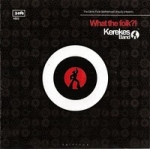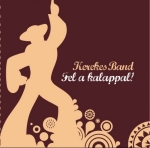New Age Hungarian Trad/Rock/Funk
Kerekes, the band from North East Hungary were taught by the old
masters of Gyimes to play traditional Hungarian music and old tunes
from Transylvania and Romania. The legacy of these 5 close friends,
brothers in music, is to interpret these old songs with a new
vigour, breathe new life, transform & transmit the melodies through
many generations from the 19th to the 21st century.
The old
melodies are still there, but now with a spectral edge, the rhythm
with a funkier beat and a new urgency. Their music proudly
announcing that it is for dancing, not just by the old people from
the villages deep in the valleys of the Carpathian Mountains but
also by the young people that dance to the heartbeat of the 21st
century Budapest night club.



Just like the dancefloor DJs of today, the members of Hungarian band Kerekes are always searching for ways to turn up the heat in their táncházok (“dance houses”). So 15 years ago, when they were still teenagers, they travelled to the countryside on foot, by bus, and by train and just like Bartók, collected living traditional folk songs in the last minute before all the masters were gone and the tradition would be lost forever. They spent eight years looking for new material and recorded over 200 hours of songs, all with the goal of bringing new-old songs to their audiences.
With a strong basis in the music of Moldova and the Gyimes region of Romania, two areas with ancient Hungarian ties, Kerekes (pronounced ker-ay-KESH, with a rolled ‘r’) has also taken cues from Jimi Hendrix and the J.B.’s, developing their own “voice”. Kerekes introduce audiences to melodies and dance rhythms rarely heard elsewhere, taking familiar sounds and updating them. All listeners will notice that the band taps the magic of the ancient shepherd’s flute, conjuring sounds never heard before on this planet. While artists like Shantel and OMFO have used electronic wizardry to bring Romanian, Moldovan, and Ukrainian sounds to the dance floor, Kerekes’ prolific live performance (including hundreds of concerts around Europe in the past 7 years; with appearances in Hungary’s top venues, The Palace of Arts and The Music Academy in Budapest; and performances on National radio & TV all over Europe and even in th Carribean
“Shepherds are the inheritors, warriors, and carriers of the ancient knowledge of the shamans,” says Zsombor Fehér, the band’s virtuosic flutist and leader. “They used their magic to heal or place curses. They could read the future.” Zsombor carries knowledge from the flute and bagpipe player István Pál (age 87), who is probably the last keeper of this ancient knowledge in Hungary. In Transylvania, the flute can magically return a lost herd to its shepherd (the melody on “Searching” brings this to mind). In Gyimes, it is said that a dead bear can be revitalized by his master with his flute.
The way Zsombor plays brings to mind the epic Robert Johnson tale when he says, “To become a good pipe player, the shepherd has to enter into collusion with the devil. They say he ‘takes his skin to the market’ and then the pipe can play itself.” Zsombor plays a shepherd’s flute on which he installed extra keys to make it chromatic. After playing the flute for about one and a half years, old relatives mentioned that both his grandfather and great-grandfather had been shepherd flute players. He later found out that all the way back to the 1700s, all his male ancestors had been shepherds, which means they had been flute players as well.
“I learned the traditional way of flute-playing from old peasants,” says Zsombor. “Having turned the flute chromatic, it is now suitable not only for pentatonic folk songs. When I realized that each shepherd flute player is a local Jimi Hendrix both in their manner of playing and musical re-creation, I saw the fusion of these two styles as completely legitimate.”
Other band members have also adapted both instruments and playing styles. Csaba Námor plays the koboz, a lute of Middle Eastern origin. “By now, all the Hungarian koboz players rest in peace, and they left behind only a couple of recordings,” says Csaba. “In the absence of masters, only rock music could show us the way.” Meanwhile, the band is proud to have convinced the largest instrument factory in Transylvania to restart the production of the koboz.
The viola has been used all over the Hungarian-speaking territories. “The Transylvanian viola is built with a flat, not curved, bridge, with three strings,” explains viola-player Ákos Csarnó. “It is played with a stronger bow made from the hair of a stallion. This allows the player to bow all three strings simultaneously in a strong rhythmic manner, playing loud chords.” Ákos plays it as if he had a “Reggae Fender Rhodes” in his hands, with his bow imitating a buzz saw.
The drum was introduced in Moldova from brass bands in the 1950s. It was played similarly to the tapan in the Balkans. Viktor Fehér had played this traditional drum for years until he realized he couldn’t play funk on a drum from Moldova, so he bought a drum-set. “Since rhythms in Hungarian music are quite fixed, we drew on rhythms of other musical cultures, mainly those of popular roots,” explains the younger Viktor.
The band is rounded out with Csaba Kónya on electric bass. Four years in the makin Pimasz earned them a 2007 Top of the World acknowledgment from Songlines magazine, a result of 200,000 readers’ votes which put them in the company of The Gotan Project, Ali Farka Toure, and Toumani Diabate.
“We knocked on the doors of old peasants’ houses not because we wanted to make world music but because we wanted to experience the real folk music of our ancestry,” concludes Zsombor Fehér. “At the time, our main motivation was to find these newly-collected tunes that our dance audiences could not possibly have heard anywhere else. However, beyond all the sophisticated reasons we could give, the heart of the matter is that we were simply spellbound by the amazing music we found, and we could not help just purely enjoying every minute of both listening to our old masters and playing with them. But now, we’re going to funkify this tradition!” In recognition of Kerekes’ efforts to modernise whilst preserving these old traditions of Hungarian music they were given the title of ‘Ambassadors of Hungarian Culture’ for the European year of Intercultural Dialogue by Katalin Bogyay, the State Secretary for International Affairs of the Hungarian Ministry of Education and Culture, the only band to be honoured by this title in Hungary.
There are two kinds of men sparking around folk music. The first loves it very much and he would close it into a museum at all costs, the other loves it so much that he would take it home at any price. The Kerekes took it home‘. Tamás Szarka - Ghymes Band






Connect with FeileAfrica
Call us today for more info +353 (0)876715151